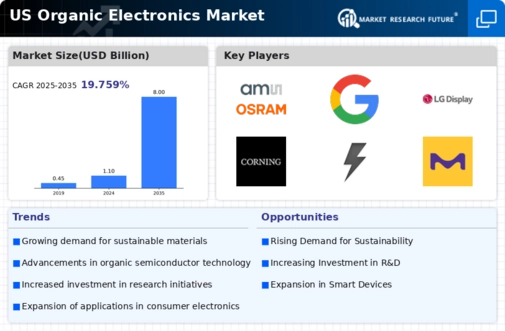The US Organic Electronics Market is characterized by its dynamic landscape, where innovation and technological advancements play a pivotal role in shaping industry trends. This market encompasses a variety of applications, including organic light-emitting diodes (OLEDs), organic photovoltaics (OPVs), and organic semiconductors, reflecting a shift toward sustainable and efficient alternatives in electronics manufacturing. Competition is fierce, with several key players vying for market share through research and development initiatives, strategic partnerships, and robust product portfolios.
As demand for organic electronic components continues to grow due to their eco-friendliness and versatility, understanding the competitive dynamics becomes crucial for stakeholders aiming to capitalize on emerging opportunities.
IBM Corporation holds a significant position within the US Organic Electronics Market, primarily recognized for its commitment to innovation and substantial investment in research and development. The company's strategic focus on leveraging organic materials for the development of advanced electronics has solidified its competitive edge. IBM has continually pushed the boundaries of organic electronic applications, particularly in areas such as OLED technology and high-performance organic semiconductors.
The company's ability to integrate cutting-edge technologies with traditional electronics forms a powerful competitive advantage, allowing IBM to cater to diverse market needs while enhancing its presence in the growing landscape of organic electronics in the United States.Osram Opto Semiconductors has established a robust foothold in the US Organic Electronics Market, primarily through its strong emphasis on high-quality products and innovative solutions.
The company specializes in LED technology, focusing on organic light-emitting diodes that excel in energy efficiency and color performance. Its product range includes a variety of integrated optical solutions that are critical in various applications, from lighting to displays. Osram Opto Semiconductors has demonstrated remarkable strength in developing partnerships and collaborations that enhance its market presence and technological capabilities. The company's forward-looking approach, including investments in mergers and acquisitions, has allowed it to adopt state-of-the-art technologies that complement its existing product offerings.
With its commitment to quality and innovation, Osram Opto Semiconductors continues to be a key player in the rapidly evolving landscape of organic electronics in the US.


















Leave a Comment